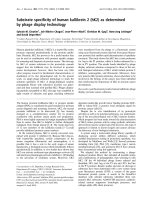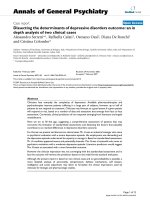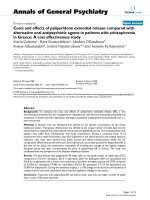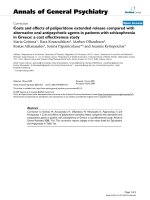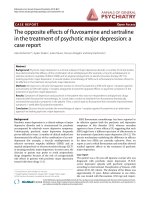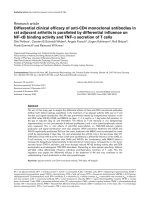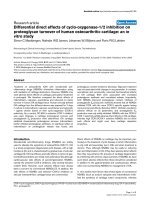Báo cáo y học: "Differential direct effects of cyclo-oxygenase-1/2 inhibition on proteoglycan turnover of human osteoarthritic cartilage: an in vitro study" pptx
Bạn đang xem bản rút gọn của tài liệu. Xem và tải ngay bản đầy đủ của tài liệu tại đây (453.06 KB, 9 trang )
Open Access
Available online />Page 1 of 9
(page number not for citation purposes)
Vol 8 No 1
Research article
Differential direct effects of cyclo-oxygenase-1/2 inhibition on
proteoglycan turnover of human osteoarthritic cartilage: an in
vitro study
Simon C Mastbergen, Nathalie WD Jansen, Johannes WJ Bijlsma and Floris PJG Lafeber
Rheumatology & Clinical Immunology, University Medical Center Utrecht, Utrecht, The Netherlands
Corresponding author: Simon C Mastbergen,
Received: 7 Jul 2005 Revisions requested: 2 Aug 2005 Revisions received: 29 Sep 2005 Accepted: 10 Oct 2005 Published: 9 Nov 2005
Arthritis Research & Therapy 2006, 8:R2 (doi:10.1186/ar1846)
This article is online at: />© 2005 Mastbergen et al.; licensee BioMed Central Ltd.
This is an open access article distributed under the terms of the Creative Commons Attribution License ( />),
which permits unrestricted use, distribution, and reproduction in any medium, provided the original work is properly cited.
Abstract
Treatment of osteoarthritis (OA) with nonsteroidal anti-
inflammatory drugs (NSAIDs) diminishes inflammation along
with mediators of cartilage destruction. However, NSAIDs may
exert adverse direct effects on cartilage, particularly if treatment
is prolonged. We therefore compared the direct effects of
indomethacin, naproxen, aceclofenac and celecoxib on matrix
turnover in human OA cartilage tissue. Human clinically defined
OA cartilage from five different donors was exposed for 7 days
in culture to indomethacin, naproxen, aceclofenac and celecoxib
– agents chosen based on their cyclo-oxygenase (COX)-2
selectivity. As a control, SC-560 (a selective COX-1 inhibitor)
was used. Changes in cartilage proteoglycan turnover and
prostaglandin E
2
production were determined. OA cartilage
exhibited characteristic proteoglycan turnover. Indomethacin
further inhibited proteoglycan synthesis; no significant effect of
indomethacin on proteoglycan release was found, and
proteoglycan content tended to decrease. Naproxen treatment
was not associated with changes in any parameter. In contrast,
aceclofenac and, prominently, celecoxib had beneficial effects
on OA cartilage. Both were associated with increased
proteoglycan synthesis and normalized release. Importantly,
both NSAIDs improved proteoglycan content. Inhibition of
prostaglandin E
2
production indirectly showed that all NSAIDs
inhibited COX, with the more COX-2 specific agents having
more pronounced effects. Selective COX-1 inhibition resulted in
adverse effects on all parameters, and prostaglandin E
2
production was only mildly inhibited. NSAIDs with low COX-2/
COX-1 selectivity exhibit adverse direct effects on OA cartilage,
whereas high COX-2/COX-1 selective NSAIDs did not show
such effects and might even have cartilage reparative
properties.
Introduction
Nonsteroidal anti-inflammatory drugs (NSAIDs) are widely
used to alleviate the symptoms of osteoarthritis (OA) [1]. OA
is a slowly progressive degenerative joint disease, with a high
incidence [2], and is characterized by gradual loss of articular
cartilage [3]. Clinical efficacy and side effects in terms of gas-
trointestinal problems are mostly well understood [4], although
cardiovascular side effects of second-generation NSAIDs,
namely the selective COX-2 inhibitors, only recently became
evident [5,6]. However, such adverse effects have always
been a concern for conventional NSAIDs [7]. In addition, the
side effects of NSAIDs and selective COX-2 inhibitors on
articular (osteoarthritic) cartilage tissue are controversial.
Direct effects of NSAIDs on cartilage may be important, par-
ticularly in the treatment of joint disease in which inflammation
is only mild and secondary (as in OA) and when treatment is
chronic. Thus, although NSAIDs may be useful in reducing
pain and inflammation in OA, if they have adverse direct effects
then they may enhance the process of cartilage degeneration
by interfering with intrinsic repair activities. If NSAIDs do have
such direct adverse effects then these should be considered
in addition to the gastrointestinal and cardiovascular effects
when one is prescribing NSAIDs for management of OA.
In vitro studies have shown that several types of conventional
NSAIDs (such as sodium salicylate and indomethacin) inhib-
ited the synthesis of cartilage matrix components, whereas
COX = cyclo-oxygenase; GAG = glycosaminoglycan; NF-κB = nuclear factor-κB; NSAID = nonsteroidal anti-inflammatory drug; OA = osteoarthritis;
PG = prostaglandin;
Arthritis Research & Therapy Vol 8 No 1 Mastbergen et al.
Page 2 of 9
(page number not for citation purposes)
others (such as aceclofenac and meloxicam) increased matrix
synthesis and protected the chondrocytes against apoptosis
[8-12]. Other NSAIDs (for instance piroxicam) had no effect.
Studies in animal models of OA verified that NSAIDs had det-
rimental or favourable actions on OA progression [13-16],
although the same NSAIDs had diverse effects on articular
cartilage in different studies, depending on the animal model
used [15,16].
With respect to the second-generation NSAIDs fewer data are
available. We recently showed a beneficial effect of celecoxib
(Celebrex; Pfizer Inc., New York, NY, USA) on normal cartilage
under the influence of interleukin-1 and tumour necrosis fac-
tor-α; in normal healthy cartilage no effects were observed
[17]. Findings reported by El Hajjaji and coworkers [18]
showed that celecoxib was able to increase proteoglycan syn-
thesis and to diminish proteoglycan release in OA cartilage
obtained at joint replacement surgery. Recent findings
reported by our group [19] confirmed these data and demon-
strated that celecoxib had a favourable effect on proteoglycan
synthesis, retention, release and content in both degenerated
(preclinical) and (late-stage) OA cartilage.
NSAIDs inhibit both COX-1 and COX-2 [20]. This inhibition
appears to be correlated with the well characterized gastroin-
testinal toxicity, with those agents with more COX-1 selectivity
having a tendency to cause more gastrointestinal damage
[21]. In contrast, a more recent debate centers on whether the
more COX-2 selective agents carry greater risk for cardiovas-
cular side effects [5,6]. In the present study we considered
whether the direct effects of NSAIDs on cartilage are depend-
ent on their COX-2 selectivity or lack thereof. It could well be
that the adverse effects on cartilage of some of the conven-
tional NSAIDs result from inhibition of COX-1.
For this reason, the present study was conducted to evaluate
the in vitro effects of several frequently used NSAIDs on
human OA articular cartilage. Effects of indomethacin and
naproxen (nonselective NSAIDs with moderate COX-1 selec-
tivity) [20] were compared with those of aceclofenac (moder-
ately selective for COX-2 [21]) and the selective COX-2
inhibitor celecoxib, covering a range from COX-1 to COX-2
selectivity.
Materials and methods
Cartilage culture technique
OA cartilage obtained from patients at knee replacement sur-
gery with diagnosed OA was obtained postoperatively. NSAID
medication was stopped 7 days before surgery, so ensuring
that there would be no confounding effect of previous medica-
tion. Cartilage that appeared to be full thickness with signifi-
cant fibrillation was selected [22], so the entire joint had a
worse appearance than represented by the cartilage used in
the evaluation. Cartilage bone samples were stored in phos-
phate-buffered saline for no longer than 4 hours. Collection of
cartilage was done according to the medical ethical regula-
tions of the University Medical Centre Utrecht.
Slices of cartilage were cut aseptically as thick as possible
from the articular bone surface (excluding the underlying
bone), cut into square pieces, weighed aseptically (range 5–
15 mg [accuracy ± 0.1 mg]) and cultured individually in 96-
well round-bottomed microtitre plates (200 µl culture medium,
5% carbon dioxide in air, 37°C). The culture medium con-
sisted of Dulbecco's modified Eagle's medium, supplemented
with glutamine (2 mmol/l), penicillin (100 IU/ml), streptomycin
sulphate (100 µg/ml), ascorbic acid (0.085 mmol/l) and 10%
heat inactivated pooled human male AB
+
serum. Cartilage was
always precultured for 24 hours (washout period), after which
culture medium was refreshed before the start of the
experiment.
In addition, three tissue samples from each donor were fixed in
4% phosphate-buffered formalin for standard light micros-
copy. Sections were stained with safranin-O fast green-iron
haematoxylin and graded for features of OA according to the
slightly modified criteria [23] presented by Mankin and cow-
orkers [24]. The tidemark between cartilage and bone was not
present in our cartilage samples and cartilage samples were
not covered with pannus. Therefore, the maximum score that
could be obtained was 11, rather than the original 14 if all cri-
teria described by Mankin and coworkers [24] (including pan-
nus, clefts to calcified zone and tidemark crossed by blood
vessels) had been included.
Experimental setup
OA human articular cartilage tissue was cultured for 7 days in
the absence or presence of the following additives: indometh-
acin (10 µmol/l; Sigma, St. Louis, MO, USA), naproxen (300
µmol/l; Sigma, St. Louis, MO, USA), aceclofenac (0.03 µmol/
l; UCB Pharma, Chemin du Foriest, Belgium), or celecoxib (1
µmol/l; supplied by Pfizer Inc., New York, NY, USA). Final con-
centrations resembled the mean pharmacological plasma con-
centrations of each of the NSAIDs [25-27]. In addition, SC-
560 (0.1 µmol/l; Sigma) – an experimental COX-1 inhibitor –
was added. A concentration of 0.1 µmol/l guarantees COX-1
selectivity; higher concentrations also inhibit COX-2. After 4
days the medium was refreshed and cartilage cultured for a
successive 3 days with the same additives. Changes in carti-
lage matrix turnover (proteoglycan synthesis, retention and
release) and matrix integrity (proteoglycan content) were
determined. Experiments were repeated five times, using car-
tilage from a different donor in each case.
Proteoglycan analyses
Sulphate incorporation rate – a measure of the rate of prote-
oglycan synthesis – was determined during the last 4 hours of
the first 4-day culture period, as described previously [28].
Before addition of
35
SO
4
2-
(Na
2
35
SO
4
, 14.8 kBq/200 µl,
DuPont NEX-041-H, carrier free), culture medium was
Available online />Page 3 of 9
(page number not for citation purposes)
replaced by equilibrated (carbon dioxide and temperature)
fresh medium. After 4 hours of labelling, the cartilage explants
were rinsed three times for 45 minutes in culture medium
under culture conditions and incubated for an additional 3
days. After this second culture period medium was removed
and the samples were stored at -20°C for further analysis. Car-
tilage tissue samples were digested (2 hours, 65°C) in papain
buffer, as described previously [22]. Papain digests were
diluted to the appropriate concentrations and glycosaminogly-
cans (GAGs) were stained and precipitated with Alcian Blue
dye solution [29]. The pellet obtained after centrifugation
(9,000 g, 10 minutes) was washed once (NaAc-buffer con-
taining 0.1 mol/l MgCl
2
) and subsequently dissolved in SDS.
The
35
SO
4
2-
radioactivity of the samples was measured by liq-
uid scintillation analysis.
35
SO
4
2-
incorporation was normalized
to the specific activity of the medium, labelling time and wet
weight of the cartilage samples. Proteoglycan synthesis rate is
expressed as percentage change compared with untreated
control values.
Release of newly formed proteoglycans as a measure of reten-
tion of these proteoglycans was similarly determined. GAGs
were precipitated from the medium obtained from days 4–7
with Alcian Blue [29]. The radiolabelled GAGs were measured
by liquid scintillation analysis and normalized to the proteogly-
can synthesis rate. Percentage release of newly formed prote-
oglycans is expressed as percentage change compared with
untreated control values.
For the total release of proteoglycans, the GAG in the medium
obtained from days 4–7 were precipitated and stained with
Alcian Blue as described above. The GAG content in the
papain digest of cartilage samples, as a measure of proteogly-
can content, was analyzed in the same way. Blue staining was
quantified photometrically by the change in absorbance at 620
nm. Chondroitin sulphate (Sigma C4383) was used as a ref-
erence. Values for content were normalized to the wet weight
of the cartilage and expressed as percentage change com-
pared with untreated control values. Values for release were
normalized to the GAG content of the explants. Percentage
release of GAGs is expressed as percentage change com-
pared with untreated control values.
Prostaglandin E
2
determination
Prostaglandin (PG)E
2
was determined in culture medium at
day 4 by enzyme immunoAssay (Caymann Chemical, Ann
Arbor, MI, USA) and expressed as percentage change com-
pared with control.
Calculations and statistical analysis
Because of focal differences in composition and bioactivity of
the cartilage in the knee joint, the results of 10 cartilage sam-
ples per parameter per donor, obtained randomly and handled
individually, were averaged and taken as a representative value
for the cartilage of that donor. Several experiments with each
cartilage sample from the different donors (n = 5) were per-
formed. Statistical evaluation of the effects of a single interven-
tion (for example NSAIDs) compared with untreated cartilage
from the same donors was performed with a nonparametric
test for paired data (Wilcoxon). For statistical evaluation of dif-
ferences between different interventions, the percentage
change compared with untreated cartilage from the same
donors was calculated. The effects of different treatments
were compared using a nonparametric test for unpaired data
(Mann-Whitney). P ≤ 0.05 were considered statistically signif-
icant.
Results
Effects of selective versus nonselective NSAIDs on
osteoarthritic cartilage
OA cartilage from the different donors had on average a mod-
ified Mankin score of 5 ± 1. It should be kept in mind that only
the cartilage that could be cut from the joint surfaces after
replacement surgery was used. Thus, the entire joint had a
worse appearance than that indicated by the modified Mankin
score of the cartilage used. Surface deterioration of the OA
cartilage was clearly visible by light microscopy. An example of
a severely affected cartilage tissue explant is shown in Figure
1b; this contrasts with the normal healthy cartilage shown in
Figure 1a. The latter was obtained from a healthy joint (post
mortem) that was not used in the present study. The safranin
O staining was lost from the surface layer of the OA samples,
and chondrocyte distribution was disturbed (clusters of
chondrocytes in the surface layer of the cartilage were visible;
Figure 1b).
Figure 1
Normal healthy and osteoarthritic cartilage histologyNormal healthy and osteoarthritic cartilage histology. Representive light
micrographs of condylar cartilage obtained post mortem from joints
with (a) normal healthy cartilage and (b) cartilage obtained at joint
replacement surgery. Sections are stained with safranin-O fast green-
iron haematoxylin and graded for features of osteoarthritis according to
the slightly modified criteria [23] described by Mankin and coworkers
[24]; scores for the shown samples are 0 and 7, respectively.
Arthritis Research & Therapy Vol 8 No 1 Mastbergen et al.
Page 4 of 9
(page number not for citation purposes)
The OA cartilage exhibited typical basal biochemical features
in terms of proteoglycan turnover (Table 1): low proteoglycan
synthesis, high proteoglycan release (both newly formed pro-
teoglycans and resident proteoglycans) and diminished prote-
oglycan content. Baseline data between the four groups did
not differ significantly. Data obtained from healthy cartilage (n
= 5; donor age 68 ± 5 years) from femoral condyles, given as
a point of reference, are as follows: histological grade 0.7 ±
0.1; proteoglycan synthesis rate 12.5 ± 1.1 nmol/hour per g;
percentage new proteoglycan release 7.1 ± 0.5%; total prote-
oglycan release 3.9 ± 0.5%; and proteoglycan content 29.2 ±
3.4 mg/g. This cartilage was obtained post mortem from
donors without any history of joint disorders and was treated
the same way over a similar time period.
Indomethacin decreased proteoglycan synthesis in OA carti-
lage (-27 ± 6% compared with untreated control OA cartilage;
P < 0.05; Figure 2, white bars). No significant effect was
found on proteoglycan release, both newly formed and resi-
dent proteoglycans. There was a tendency toward a decrease
in proteoglycan content (on average -11 ± 4%). Naproxen had
no significant effects on proteoglycan turnover in OA cartilage,
although there was a tendency for this agent to exert effects
similar to those of indomethacin. Remarkably, naproxen
resulted in a slight but statistically significant increase in pro-
teoglycan content (14 ± 4%; P < 0.05; Figure 2, light grey
bars).
In contrast to indomethacin and naproxen, treatment with ace-
clofenac, which is more selective for COX-2 inhibition [21],
was associated with improvements in all parameters (Figure
2a, dark grey bars). Proteoglycan synthesis was on average
increased by 15 ± 10%, although this finding was not statisti-
cally significant. However, this increased synthesis was com-
bined with an improved retention of these newly formed
proteoglycans, as reflected by the diminished rate of release
of newly formed proteoglycans (-25 ± 10%; P < 0.05). This
was also the case for the total proteoglycan release, which
was reduced (-16 ± 6%; P < 0.05). More importantly, ace-
clofenac improved the proteoglycan content on average by 27
± 19% (P < 0.05).
The most selective COX-2 inhibitor of the four tested, namely
celecoxib, caused even greater improvement in proteoglycan
parameters as compared with untreated controls (Figure 2,
black bars). Proteoglycan synthesis increased 57 ± 22% (P <
0.05), whereas the release of those newly formed proteogly-
cans was reduced by 38 ± 12% (P < 0.05). A comparable
reduction was found for total proteoglycan release (-32 ± 4%;
P < 0.05). With respect to matrix integrity, celecoxib was able
to improve the proteoglycan content by 32 ± 9 % (P < 0.05).
When the effects of aceclofenac and celecoxib were com-
pared with those of indomethacin and naproxen, the beneficial
effects of the former were significantly different from the
adverse effects of the latter in terms of proteoglycan synthesis,
retention, release and content (Figure 2). All NSAIDs inhibited
PGE
2
, as an indirect measure of COX inhibiting activity (on
average, more than 60% inhibition for all compounds com-
pared with untreated controls; P < 0.05; Figure 3). However,
there was a tendency for greater COX-2 selectivity in an
NSAID to correlate with more pronounced inhibition of PGE
2
.
Unfortunately, the culture media from the aceclofenac samples
could not be analyzed.
Effects of SC-560 on osteoarthritic cartilage
Because it appeared that absence of selectivity for COX-2
inhibition resulted in no or even adverse direct effects on car-
tilage, we studied the effect of an experimental selective COX-
1 inhibitor as well. In these experiments the average age of
donors was 73 ± 3 years and they were all female. The aver-
age modified Mankin grade of these donors was 6 ± 1. The
donors did not differ significantly from the other OA donors for
any of the parameters given in Table 1.
When SC-560 was added to the OA cartilage cultures, an
inhibition of proteoglycan synthesis (-10 ± 9% compared with
untreated control; P < 0.05; Figure 4) was found. This was
Table 1
Histological and biochemical characteristics of baseline values of human osteoarthritic cartilage for different treatment groups
Parameter Indomethacin
(10 µmol/l)
Naproxen
(300 µmol/l)
Aceclofenac
(0.03 µmol/l)
Celecoxib
(0.01 µmol/l)
Age (years) 70 ± 2 67 ± 3 63 ± 2 70 ± 3
Sex (female/male) 4/1 3/2 4/1 4/1
Histological cartilage damage (Mankin grade) 3 ± 1 4 ± 1 6 ± 2 5 ± 2
Prostaglandin synthesis rate (nmol/hour per g) 6.8 ± 2.3 3.4 ± 1.9 4.8 ± 0.9 5.5 ± 1.8
% New prostaglandin release 11 ± 2 13 ± 2 12 ± 2 11 ± 2
% Total release 9 ± 2 7 ± 2 5 ± 1 6 ± 1
Prostaglandin content (mg/g) 22 ± 2 19 ± 1 17 ± 6 19 ± 1
Available online />Page 5 of 9
(page number not for citation purposes)
accompanied by enhanced release of newly formed proteogly-
cans (10 ± 10% compared with untreated control; P < 0.05).
There was no statistically significant change in total proteogly-
can release. The inhibition in synthesis and retention did not
lead to a further statistically significant reduction in proteogly-
can content, although there was a tendency toward a
decrease in proteoglycan content. Inhibition of PGE
2
produc-
tion was relatively mild compared with that induced by NSAIDs
(on average by 30 ± 15%; P < 0.05). The effects of this selec-
tive COX-1 inhibitor were not significantly different from those
of the nonselective NSAIDs, but for all parameters they were
statistically different from the (more) COX-2 selective NSAIDs
(data not shown).
Discussion
The purpose of this study was to evaluate the effect of fre-
quently used NSAIDs on human OA articular cartilage in vitro.
There was an emphasis on possible differences between con-
ventional nonselective COX-2 inhibitors and the more selec-
tive COX-2 inhibitors, as recently classified by Warner and
Mitchell [20]. It appeared that COX-2 selectivity resulted in
cartilage reparative properties, whereas the absence of COX-
2 selectivity could even result in negative effects. The adverse
effects of an experimental COX-1 selective compound corrob-
orate the latter finding.
Although we calculated that the concentrations of NSAIDs
used in vitro were likely to be close to the concentrations of
NSAIDs found in vivo, it should be considered that the actual
concentrations reached in vivo in patients might be slightly dif-
ferent from the in vitro concentrations in this study because of
low concentrations of binding proteins such as albumin (the
culture medium included only 10% human serum) [30].
However, we expect the binding of the different NSAIDs to be
comparable, and so the observed differences between the
Figure 2
Effects of four NSAIDs on proteoglycan turnover and content of OA cartilageEffects of four NSAIDs on proteoglycan turnover and content of OA
cartilage. Shown are the following measures of proteoglycan turnover:
(a) percentage change in proteoglycan synthesis rate (compared with
untreated osteoarthritic cartilage of the same donor), as a measure of
cartilage matrix synthesis (proteoglycan synthesis); (b) percentage
release of newly formed proteoglycans (new proteoglycan release), as
a measure of retention of newly formed proteoglycans (normalized to
the synthesis of these proteoglycans); (c) percentage total release of
proteoglycans (total proteoglycan release), measured as the percent-
age release of glycosaminoglycans (normalized to the glycosaminogly-
can content); and (d) proteoglycan content (proteoglycan content).
White bars represent effects of indomethacin (10 µmol/l); light grey
bars represent naproxen (300 µmol/l), dark grey bars represent ace-
clofenac (0.03 µmol/l) and black bars represent celecoxib (1 µmol/l).
The results are presented as means of five experiments (with each carti-
lage sample from the different donors) ± standard error. Statistically
significant differences for the effect of an NSAID compared with OA
cartilage of the same donors is calculated using nonparametric paired
analysis (*P < 0.05). Difference between percentage changes for the
two nonselective NSAIDs compared with the (more) selective NSAIDs
(n = 10 versus n = 10) is calculated by nonparametric, nonpaired anal-
ysis (P values are given for each of the parameters). NSAID, nonsteroi-
dal anti-inflammatory drug; OA, osteoarthritis.
Figure 3
Effects of three of the four NSAIDs on PGE
2
production in OA cartilageEffects of three of the four NSAIDs on PGE
2
production in OA carti-
lage. Percentage changes in PGE
2
levels in culture supernatants of
osteoarthritic cartilage treated with different NSAIDs are shown. Mean
values (n = 5 ± standard error) are presented for indomethacin (open
bar), naproxen (light grey bar) and celecoxib (black bar). Effects of ace-
clofenac were not measured. Statistical differences of the effects of the
different NSAIDs compared with untreated controls were calculated
using nonparametric paired analysis (*P < 0.05). NSAID, nonsteroidal
anti-inflammatory drug; OA, osteoarthritis; PG, prostaglandin.
Arthritis Research & Therapy Vol 8 No 1 Mastbergen et al.
Page 6 of 9
(page number not for citation purposes)
effects of the different NSAIDs should be consistent in vitro
and in vivo.
The direct negative effects of indomethacin are mainly
reflected by an inhibition of proteoglycan synthesis and dimin-
ished retention of these newly formed proteoglycans. This is in
accordance with previous reports that examined frequently
used NSAIDs. Indomethacin, naproxen and ibuprofen, tested
under comparable in vitro conditions, are known to inhibit the
synthesis of cartilage proteoglycans [9,10,31,32] and to
increase the release of proteoglycans [9,10]. In addition,
indomethacin was found to have deleterious effects on articu-
lar cartilage of both left and right knees in OA rats induced by
injections of sodium iodoacetate in the right knee [9].
Indomethacin has also been demonstrated to affect glycosyl-
transferase; this is important for the synthesis of the polysac-
charide chains of proteoglycans [33] and might have affected
the measured sulphate incorporation rate. Also, naproxen
exhibited adverse effects in an in vivo study using the ACLT
canine model of OA [16]. That study found that naproxen
increased water content in cartilage. However, a different
ACLT canine study [15] showed that naproxen was able to
suppress significantly the decreases in proteoglycan content
and metalloproteinase activities in knee articular cartilage [15].
In our hands naproxen did not have a pronounced adverse
effect on OA cartilage in vitro, as previously demonstrated,
although there was a tendency toward such an effect. With
respect to the direct effects of selective COX-2 inhibitors on
cartilage, recent data showed a beneficial effect of celecoxib
in normal cartilage under inflammatory conditions; normal
healthy cartilage remained unaffected [17]. For OA cartilage
obtained at joint replacement surgery, it was demonstrated
that celecoxib could increase proteoglycan synthesis and
diminish proteoglycan release [18]. Recently, our group con-
firmed these findings and showed that celecoxib had a favour-
able effect on proteoglycan synthesis, retention, release and
content in both degenerated (preclinical) and (late-stage) OA
cartilage [19]. Remarkably, the effects of aceclofenac, a deri-
vate of diclofenac, were similar to those of celecoxib, suggest-
ing a similar mechanism of action. Based on the classification
presented by Warner and coworkers [21] diclofenac has a
preference for COX-2; from this and our findings, we assume
that aceclofenac has comparable selectivity. The metabolism
of aceclofenac differs from that of diclofenac and is human
specific [34]. The main metabolite of aceclofenac is 4-hydroxy-
aceclofenac. The other metabolites, namely diclofenac and 4-
hydroxy-diclofenac, account for only 5% of the administered
dose [25]. Aceclofenac acts as a functional inhibitor of PGE
2
production, either by acting directly on the production of
cytokines that induce COX in the inflamed tissues [35] or by
its preferential intracellular conversion to COX(-2) active
metabolites [36,37], or most likely by both processes at the
same time [37].
The experimental selective COX-1 inhibitor SC-560 had
effects similar to those of indomethacin, indicating that inhibi-
tion of COX-1 results in an adverse effect on proteoglycan
synthesis and retention. In contrast, when COX-2 is selectively
inhibited in OA cartilage we found a beneficial effect with
respect to proteoglycan turnover. These findings imply an
important role for COX-2 in the disturbed proteoglycan turno-
ver in OA, whereas COX-1 plays a more physiological role in
the chondrocytes. This is in accordance with the generally
held belief that COX-1 is the 'housekeeping' isoform of COX
and has clear physiological functions. For instance, its activa-
tion leads to the production of prostacyclin, which when
released by the endothelium is antithrombogenic and when
released by the gastric mucosa is cytoprotective [38]. In con-
trast, COX-2 is excessively induced under inflammatory and
detrimental conditions such as OA. This established concept
has been modified by recent investigations demonstrating a
significant participation of prostaglandins derived via the
COX-1 pathway in some inflammatory processes [39-41],
especially pain. Also, the recent identification of cardiovascu-
lar side effects of selective COX-2 inhibitors, and NSAIDs in
general, forces us to reconsider the current concept.
Nevertheless, in the case of proteoglycan turnover in OA car-
tilage the concept apparently still holds true.
Figure 4
Effect of a selective COX-1 inhibition on OA cartilageEffect of a selective COX-1 inhibition on OA cartilage. Shown are the
percentage changes compared with healthy cartilage of proteoglycan
synthesis rate as a measure of cartilage matrix synthesis (pg synthesis);
percentage release of newly formed proteoglycans (new pg release) as
a measure of retention of the newly formed proteoglycans (normalized
to the synthesis of these proteoglycans); percentages total release of
proteoglycans (total pg release), measured as the percentage release
of glycosaminoglycans (normalized to glycosaminoglycan content); pro-
teoglycan content (pg content) and prostaglandin E
2
release (pge
2
release) under the influence of 0.1 µmol/l SC-560 (a selective COX-1
inhibitor). The results are presented as means of five experiments (with
each cartilage sample from the different donors) ± standard error. The
absolute values of untreated controls are as follows: prostaglandin syn-
thesis rate 3.4 ± 1.3 nmol/hour per g; % new prostaglandin release
11.4 ± 0.6%; total prostaglandin release 6.4 ± 1.1%; and prostaglan-
din content 17.9 ± 0.8 mg/g. Significant differences between SC-560
treated and untreated cartilage were calculated using nonparametric
paired analysis (*P < 0.05).
Available online />Page 7 of 9
(page number not for citation purposes)
COX-2 is expressed in OA tissues. The expression of COX-2
and PGE
2
in OA meniscus, synovial membrane, osteophytic
fibrocartilage and in the articular OA cartilage has been
described [42]. However, when we selectively inhibited COX-
1, thereby inhibiting only a relatively small amount of PGE
2
,
proteoglycan turnover became worse (especially proteoglycan
synthesis). This indicates that COX-1 inhibition results in alter-
ations to products formed by COX-1 in a mechanism that is
independent of PGE
2
, which influences proteoglycan turnover
negatively. The difference in outcome when COX-1 or COX-2
is inhibited can be explained by the possibility that the two
COX isoforms may actually have different primary products
through preferential interaction with different terminal syn-
thases [43], irrespective of the final product, namely PGE
2
.
Another factor might be the different intracellular localization of
the two COX isoforms, which might lead to (unknown) alterna-
tive effects of the same prostaglandin products [43]. Never-
theless, the upregulation of PGE
2
in OA cartilage, together
with the beneficial effects of COX-2 inhibition, implies an
important role for COX-2 in OA cartilage and supports the use
of selective COX-2 inhibitors in treatment of OA.
Other, COX independent effects of NSAIDs might be involved
as well, however [44]. Several studies have demonstrated that
certain NSAIDs, such as ibuprofen, cause anti-inflammatory
effects independent of COX activity and prostaglandin synthe-
sis inhibition [45-47]. These effects are mediated through inhi-
bition of certain transcription factors such as nuclear factor
(NF)-κB and activator protein-1 [48-50]. The respective
NSAIDs might interfere directly with the transcription factors,
but their effects are probably mediated predominantly through
alterations of the activity of cellular kinases such as IKKβ, Erk,
p38, or mitogen-activated protein kinase [51]. These effects
are not shared by all NSAIDs, because indomethacin failed to
inhibit NF-κB and activator protein-1 activation, as well as Erk
activity [49,52,53]. In contrast, indomethacin is able to acti-
vate peroxisome proliferator-activated receptor-γ, which is not
sensitive to sodium salicylate or aspirin [54]. At the concentra-
tion tested, celecoxib inhibits NF-κB, an effect also observed
for other NSAIDs but only at higher concentrations [55]. Inhi-
bition of NF-κB is related to inhibition of matrix metalloprotein-
ases and aggrecanases [56]. These effects may add to the
observed differences in direct effects of NSAIDs on cartilage.
Importantly, we discussed solely the direct effects of NSAIDs
on cartilage. These effects should be seen within the context
of the significant anti-inflammatory effects of these NSAIDs.
By inhibiting joint inflammation, they may indirectly be benefi-
cial to cartilage, specifically when inflammation is primary in
the cause of cartilage damage, as is the case for rheumatoid
arthritis. However, in OA, in which inflammation may contribute
to but is not primarily responsible for cartilage damage,
adverse direct effects of NSAIDs on cartilage with long-term
treatment may have an important impact on long-term out-
come. Therefore it remains important to extend these in vitro
studies with animal in vivo studies and even clinical setups.
Conclusion
Although they are in vitro findings, the results of the present
study suggest that, in addition to the anti-inflammatory and
analgesic characteristics of selective COX-2 inhibitors, their
gastrointestinal and their cardiovascular side effects, the
direct (side) effects of these NSAIDs on cartilage should also
be considered in the choice of NSAID during chronic treat-
ment of joint diseases such as OA.
Competing interests
This investigation was supported by an unrestricted grant from
Pfizer and UCB Pharma.
Authors' contributions
SM, JB, and FL conceived the study, participated in its design
and coordination, and helped to draft the manuscript. SM and
NJ carried out the experiments and performed all of the assays.
All authors read and approved the final manuscript.
Acknowledgements
FPJGL is supported by the Dutch Arthritis Association.
References
1. Hungin AP, Kean WF: Nonsteroidal anti-inflammatory drugs:
overused or underused in osteoarthritis? Am J Med 2001,
110:8S-11S.
2. Dieppe PA, Lohmander LS: Pathogenesis and management of
pain in osteoarthritis. Lancet 2005, 365:965-973.
3. Goldring MB: The role of the chondrocyte in osteoarthritis.
Arthritis Rheum 2000, 43:1916-1926.
4. Lazzaroni M, Bianchi Porro G: Gastrointestinal side-effects of
traditional non-steroidal anti-inflammatory drugs and new
formulations. Aliment Pharmacol Ther 2004, 20 Suppl 2:48-58.
5. Bombardier C, Laine L, Reicin A, Shapiro D, Burgos-Vargas R,
Davis B, Day R, Ferraz MB, Hawkey CJ, Hochberg MC, et al.:
Comparison of upper gastrointestinal toxicity of rofecoxib and
naproxen in patients with rheumatoid arthritis. VIGOR Study
Group. N Engl J Med 2000, 343:1520-1528.
6. Farkouh ME, Kirshner H, Harrington RA, Ruland S, Verheugt FW,
Schnitzer TJ, Burmester GR, Mysler E, Hochberg MC, Doherty M,
et al.: Comparison of lumiracoxib with naproxen and ibuprofen
in the Therapeutic Arthritis Research and Gastrointestinal
Event Trial (TARGET), cardiovascular outcomes: randomised
controlled trial. Lancet 2004, 364:675-684.
7. Howard PA, Delafontaine P: Nonsteroidal anti-Inflammatory
drugs and cardiovascular risk. J Am Coll Cardiol 2004,
43:519-525.
8. Blot L, Marcelis A, Devogelaer JP, Manicourt DH: Effects of
diclofenac, aceclofenac and meloxicam on the metabolism of
proteoglycans and hyaluronan in osteoarthritic human
cartilage. Br J Pharmacol 2000, 131:1413-1421.
9. Ding C: Do NSAIDs affect the progression of osteoarthritis?
Inflammation 2002, 26:139-142.
10. Dingle JT: The effect of nonsteroidal antiinflammatory drugs on
human articular cartilage glycosaminoglycan synthesis. Oste-
oarthritis Cartilage 1999, 7:313-314.
11. Henroitin Y, Reginster JY: In-vitro differences among nonsteroi-
dal antiinflammatory drugs in their activities related to oste-
oarthritis pathophysiology. Osteoarthritis Cartilage 1999,
7:355-357.
12. Mukherjee P, Rachita C, Aisen PS, Pasinetti GM: Non-steroidal
anti-inflammatory drugs protect against chondrocyte apop-
totic death. Clin Exp Rheumatol 2001, 19:S7-S11.
Arthritis Research & Therapy Vol 8 No 1 Mastbergen et al.
Page 8 of 9
(page number not for citation purposes)
13. Fernandes JC, Caron JP, Martel-Pelletier J, Jovanovic D, Mineau F,
Tardif G, Otterness IG, Pelletier JP: Effects of tenidap on the pro-
gression of osteoarthritic lesions in a canine experimental
model. Suppression of metalloprotease and interleukin-1
activity. Arthritis Rheum 1997, 40:284-294.
14. Pelletier JP, Lajeunesse D, Jovanovic DV, Lascau-Coman V, Joli-
coeur FC, Hilal G, Fernandes JC, Martel-Pelletier J: Carprofen
simultaneously reduces progression of morphological
changes in cartilage and subchondral bone in experimental
dog osteoarthritis. J Rheumatol 2000, 27:2893-2902.
15. Ratcliffe A, Azzo W, Saed-Nejad F, Lane N, Rosenwasser MP,
Mow VC: In vivo effects of naproxen on composition, prote-
oglycan metabolism, and matrix metalloproteinase activities in
canine articular cartilage. J Orthop Res 1993, 11:163-171.
16. Serni U, Mannoni A, Benucci M: Is there preliminary in-vivo evi-
dence for an influence of nonsteroidal antiinflammatory drugs
on progression in osteoarthritis? Part II-evidence from animal
models. Osteoarthritis Cartilage 1999, 7:351-352.
17. Mastbergen SC, Lafeber FP, Bijlsma JW: Selective COX-2 inhibi-
tion prevents proinflammatory cytokine-induced cartilage
damage. Rheumatology (Oxford) 2002, 41:801-808.
18. El Hajjaji H, Marcelis A, Devogelaer JP, Manicourt DH: Celecoxib
has a positive effect on the overall metabolism of hyaluronan
and proteoglycans in human osteoarthritic cartilage. J
Rheumatol 2003, 30:2444-2451.
19. Mastbergen SC, Bijlsma JW, Lafeber FP: Selective COX-2 inhibi-
tion is favorable to human early and late-stage osteoarthritic
cartilage: a human in vitro study. Osteoarthritis Cartilage 2005,
13:519-526.
20. Warner TD, Mitchell JA: Cyclooxygenases: new forms, new
inhibitors, and lessons from the clinic. FASEB J 2004,
18:790-804.
21. Warner TD, Giuliano F, Vojnovic I, Bukasa A, Mitchell JA, Vane JR:
Nonsteroid drug selectivities for cyclo-oxygenase-1 rather
than cyclo-oxygenase-2 are associated with human gastroin-
testinal toxicity: a full in vitro analysis. Proc Natl Acad Sci USA
1999, 96:7563-7568.
22. Lafeber FP, Vander Kraan PM, Huber-Bruning O, Vanden Berg
WB, Bijlsma JW: Osteoarthritic human cartilage is more sensi-
tive to transforming growth factor beta than is normal
cartilage. Br J Rheumatol 1993, 32:281-286.
23. Lafeber FP, van der Kraan PM, van Roy HL, Vitters EL, Huber-Brun-
ing O, van den Berg WB, Bijlsma JW: Local changes in prote-
oglycan synthesis during culture are different for normal and
osteoarthritic cartilage. Am J Pathol 1992, 140:1421-1429.
24. Mankin HJ, Dorfman H, Lippiello L, Zarins A: Biochemical and
metabolic abnormalities in articular cartilage from osteo-
arthritic human hips. II. Correlation of morphology with bio-
chemical and metabolic data. J Bone Joint Surg Am 1971,
53:523-537.
25. Bort R, Ponsoda X, Carrasco E, Gomez-Lechon MJ, Castell JV:
Metabolism of aceclofenac in humans. Drug Metab Dispos
1996, 24:834-841.
26. Paulson SK, Hribar JD, Liu NW, Hajdu E, Bible RH Jr, Piergies A,
Karim A: Metabolism and excretion of [
14
C]celecoxib in healthy
male volunteers. Drug Metab Dispos 2000, 28:308-314.
27. Schulz M, Schmoldt A: Therapeutic and toxic blood concentra-
tions of more than 800 drugs and other xenobiotics. Phar-
mazie 2003, 58:447-474.
28. Lafeber FP, Vander Kraan PM, Van Roy JL, Huber-Bruning O,
Bijlsma JW: Articular cartilage explant culture; an appropriate
in vitro system to compare osteoarthritic and normal human
cartilage. Connect Tissue Res 1993, 29:287-299.
29. Whiteman P: The quantitative determination of gly-
cosaminoglycans in urine with Alcian Blue 8GX. Biochem J
1973, 131:351-357.
30. Curry SL, Cogar SM, Cook JL: Nonsteroidal antiinflammatory
drugs: a review. J Am Anim Hosp Assoc 2005, 41:298-309.
31. Collier S, Ghosh P: Comparison of the effects of non-steroidal
anti-inflammatory drugs (NSAIDs) on proteoglycan synthesis
by articular cartilage explant and chondrocyte monolayer
cultures. Biochem Pharmacol 1991, 41:1375-1384.
32. Smith RL, Kajiyama G, Lane NE: Nonsteroidal antiinflammatory
drugs: effects on normal and interleukin 1 treated human
articular chondrocyte metabolism in vitro. J Rheumatol 1995,
22:1130-1137.
33. David MJ, Vignon E, Peschard MJ, Broquet P, Louisot P, Richard
M: Effect of non-steroidal anti-inflammatory drugs (NSAIDS)
on glycosyltransferase activity from human osteoarthritic
cartilage. Br J Rheumatol 1992, 31 Suppl 1:13-17.
34. Bort R, Ponsoda X, Carrasco E, Gomez-Lechon MJ, Castell JV:
Comparative metabolism of the nonsteroidal antiinflammatory
drug, aceclofenac, in the rat, monkey, and human. Drug Metab
Dispos 1996, 24:969-975.
35. Henrotin Y, de Leval X, Mathy-Hartet M, Mouithys-Mickalad A,
Deby-Dupont G, Dogne JM, Delarge J, Reginster JY: In vitro
effects of aceclofenac and its metabolites on the production
by chondrocytes of inflammatory mediators. Inflamm Res
2001, 50:391-399.
36. Hinz B, Rau T, Auge D, Werner U, Ramer R, Rietbrock S, Brune K:
Aceclofenac spares cyclooxygenase 1 as a result of limited
but sustained biotransformation to diclofenac. Clin Pharmacol
Ther 2003, 74:222-235.
37. Yamazaki R, Kawai S, Matsuzaki T, Kaneda N, Hashimoto S,
Yokokura T, Okamoto R, Koshino T, Mizushima Y: Aceclofenac
blocks prostaglandin E2 production following its intracellular
conversion into cyclooxygenase inhibitors. Eur J Pharmacol
1997, 329:181-187.
38. Vane JR, Botting RM: Mechanism of action of nonsteroidal anti-
inflammatory drugs. Am J Med 1998, 104:2S-8S.
39. Knorth H, Dorfmuller P, Lebert R, Schmidt WE, Wittenberg RH,
Heukamp M, Wiese M, Willburger RE: Participation of cyclooxy-
genase-1 in prostaglandin E2 release from synovitis tissue in
primary osteoarthritis in vitro. Osteoarthritis Cartilage 2004,
12:658-666.
40. Loftin CD, Tiano HF, Langenbach R: Phenotypes of the COX-
deficient mice indicate physiological and pathophysiological
roles for COX-1 and COX-2. Prostaglandins Other Lipid Mediat
2002, 68-69:177-185.
41. Martinez RV, Reval M, Campos MD, Terron JA, Dominguez R,
Lopez-Munoz FJ: Involvement of peripheral cyclooxygenase-1
and cyclooxygenase-2 in inflammatory pain. J Pharm
Pharmacol 2002, 54:405-412.
42. Hardy MM, Seibert K, Manning PT, Currie MG, Woerner BM,
Edwards D, Koki A, Tripp CS: Cyclooxygenase 2-dependent
prostaglandin E2 modulates cartilage proteoglycan degrada-
tion in human osteoarthritis explants. Arthritis Rheum 2002,
46:1789-1803.
43. Morita I: Distinct functions of COX-1 and COX-2. Prostaglandins
Other Lipid Mediat 2002, 68-69:165-175.
44. Tegeder I, Pfeilschifter J, Geisslinger G: Cyclooxygenase-inde-
pendent actions of cyclooxygenase inhibitors. FASEB J 2001,
15:2057-2072.
45. McCracken JD, Wechter WJ, Liu Y, Chase RL, Kantoci D, Murray
ED Jr, Quiggle DD, Mineyama Y: Antiproliferative effects of the
enantiomers of flurbiprofen. J Clin Pharmacol 1996,
36:540-545.
46. Shiff SJ, Qiao L, Tsai LL, Rigas B: Sulindac sulfide, an aspirin-
like compound, inhibits proliferation, causes cell cycle quies-
cence, and induces apoptosis in HT-29 colon adenocarcinoma
cells. J Clin Invest 1995, 96:491-503.
47. Zhang X, Morham SG, Langenbach R, Young DA: Malignant
transformation and antineoplastic actions of nonsteroidal anti-
inflammatory drugs (NSAIDs) on cyclooxygenase-null embryo
fibroblasts. J Exp Med 1999, 190:451-459.
48. Cronstein BN, Montesinos MC, Weissmann G: Salicylates and
sulfasalazine, but not glucocorticoids, inhibit leukocyte accu-
mulation by an adenosine-dependent mechanism that is inde-
pendent of inhibition of prostaglandin synthesis and p105 of
NFkappaB. Proc Natl Acad Sci USA 1999, 96:6377-6381.
49. Oeth P, Mackman N: Salicylates inhibit lipopolysaccharide-
induced transcriptional activation of the tissue factor gene in
human monocytic cells. Blood 1995, 86:4144-4152.
50. Pierce JW, Read MA, Ding H, Luscinskas FW, Collins T: Sali-
cylates inhibit I kappa B-alpha phosphorylation, endothelial-
leukocyte adhesion molecule expression, and neutrophil
transmigration. J Immunol 1996, 156:3961-3969.
51. Huang C, Ma WY, Hanenberger D, Cleary MP, Bowden GT, Dong
Z: Inhibition of ultraviolet B-induced activator protein-1 (AP-1)
activity by aspirin in AP-1-luciferase transgenic mice. J Biol
Chem 1997, 272:26325-26331.
52. Weber C, Erl W, Pietsch A, Weber PC: Aspirin inhibits nuclear
factor-kappa B mobilization and monocyte adhesion in stimu-
Available online />Page 9 of 9
(page number not for citation purposes)
lated human endothelial cells. Circulation 1995,
91:1914-1917.
53. Yamamoto Y, Yin MJ, Lin KM, Gaynor RB: Sulindac inhibits acti-
vation of the NF-kappaB pathway. J Biol Chem 1999,
274:27307-27314.
54. Lehmann JM, Lenhard JM, Oliver BB, Ringold GM, Kliewer SA:
Peroxisome proliferator-activated receptors alpha and
gamma are activated by indomethacin and other non-steroidal
anti-inflammatory drugs. J Biol Chem 1997, 272:3406-3410.
55. Takada Y, Bhardwaj A, Potdar P, Aggarwal BB: Nonsteroidal
anti-inflammatory agents differ in their ability to suppress NF-
kappaB activation, inhibition of expression of cyclooxygenase-
2 and cyclin D1, and abrogation of tumor cell proliferation.
Oncogene 2004, 23:9247-9258.
56. Sylvester J, Liacini A, Li WQ, Zafarullah M: Interleukin-17 signal
transduction pathways implicated in inducing matrix metallo-
proteinase-3, -13 and aggrecanase-1 genes in articular
chondrocytes. Cell Signal 2004, 16:469-476.

